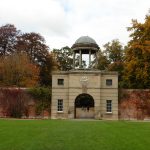Today we split up and went on separate days out. Whilst Michele went off to the Savoy for High Tea, I headed down the motorway to Harmondsworth to visit the Harmondsworth Great Barn. The barn is England’s oldest and biggest wooden structure, and also oldest barn.
Situated not far from the airport at Harmondsworth we became interested after seeing an advertisement for the open day. The Harmondsworth Great Barn is an English Heritage property open ever second Sunday from April until October and entry was free. It’s staffed by a group of local volunteers from the Friends of the Great Barn. They’ve been involved with the preservation of the site and the stories attached to it.
Who Built The Barn

The barn was built by William of Wykeham, Bishop of Winchester and Chancellor to both Edward III and Richard II, in the 15th century. In the days before mechanisation and the invention of harvesters, crops were harvested using a scythe. The bushels of grain were then stored in the barn still attached to the stalk. During the winter months when there was less work to be done the grain was then separated from the stalks using flails. After collecting all the grain it was stored in a granary. The hay was then used for fodder and for animals.
The area around Harmondsworth Great Barn wasn’t just any ordinary land, it was grade one agricultural land. When you contemplate that only three percent of UK is grade one agricultural land the land around here is too good to have houses on. It rates amongst some of the best land in the world.
Harmondsworth Great Barn was in use by three families right up until the late 1970’s when it was sold to a building group who built their offices in a complementary style. After they went belly up in 2006 some property speculators snapped up the property banking on the fact that the Heathrow Airport expansion would resume the property and they would cash in. It wasn’t to be and the pretty dilapidated barn was purchased and repaired by English Heritage.
How The Barn Was Built

It’s quite fascinating looking at 600 year old oak beams still in place after all those years. In the whole barn there were only 176 steel nails used in the construction and in most cases wooden pegs were used. An inventory of the construction confirms all the materials used in construction. Its unbelievable that the document still exists. In the barn are displays of different parts of the construction. The clay tile roof display was quite interesting during fabrication of the tiles two holes were drilled in the top. When the roof was tiled the tiles were held in place by wooden pegs.
An audio display in the barn played stories from local people about the history of the barn and life growing up around the area. It was quite nice listening to the stories and learning how the area changed.
The display told how since early times the area was a grain growing area, growing barley, wheat and corn. After the land enclosure act, in 1819 the land was enclosed and smaller holdings developed. It signalled a change in land practices and ushered in a change of crops. With the onset of the twentieth century the area became a fruit growing region. The Sipson fruit bottling company established itself in the nearby village of Sipson.
The Future Of the Barn

By the 1920’s most of the area became market gardens supplying the hungry mouths of nearby London.
With the coming of the second world war and afterwards Heathrow airport was expanded, gobbling up all the little medieval villages. These days signs around the area warn of the impending expansion. Before government at the moment are plans to expand various London airports to support the ever increasing volume of air traffic flying in and out of London. The expansion of another runway at Heathrow threatens the village of Harmondsworth.
Although Harmondsworth Great Barn is not one of UK’s main attractions it would be a shame to see such an important building replaced by a slab of concrete. But we live in hope for Harmondsworth Great Barn.






